
Review Article
Austin Crit Care J. 2017; 4(1): 1020.
sICAM as a Predictor of Outcome in Acute Spontaneous Intracerebral Hemorrhage
Mohamed H1, Hussein A2, Risk A3, Fawzy M2, Sherif AA2 and Ibrahim I4*
1Department of Critical Care Medicine, International Medical Centre, Saudi Arabia
2Department of Critical Care Medicine, Cairo University, Egypt
3Department of Clinical Pathology, Department of Critical Care, Cairo University, Egypt
4Department of Pulmonary and critical care medicine, University of California San Diego, USA
*Corresponding author: Islam Ibrahim, Department of Pulmonary and Critical Care Medicine, University of California San Diego, USA
Received: February 27, 2017; Accepted: September 13, 2017; Published: September 22, 2017
Abstract
Background: Serum concentrations of adhesion molecules may be connected to the pathogenesis of secondary brain injury after spontaneous Intracerebral Hemorrhage (ICH). This study posits the hypothesis that levels of adhesion molecules substantially increase after ICH and are decreased thereafter, and that they can predict treatment outcomes.
Methods: Our study was conducted as a prospective study on 25 patients with acute spontaneous ICH presenting to ED of AL Sahel teaching hospital over a period of 19 months (May 2014 to November 2015) confirmed by patient history and brain CT scan. The studied population was divided into two groups; group 1(25 patients) with acute ICH and group 2(25) young volunteers. Patients in both groups were investigated with serial serum levels of sICAM during their hospital stay; the results of the 2 groups were compared. The case group was divided according to the outcome into two subgroups; bad outcome and good outcome by using the Modified Rankin Disability Scale (mMRS).
Results: Fifteen patients had bad outcome and 10 had good outcome. Cutoff point for the studied population for sICAM level on admission at 455 ng/ml could predict poor outcome with sensitivity 73% and specificity 80%, at 680 ng/ ml could predict clinical seizures at sensitivity 100% and specificity 81% and at 505 ng/ml could predict non survivors with sensitivity 89% and specificity 88%.
Conclusion: Persistent increase in sICAM level implies a danger of poor therapeutic outcome for the treatment of spontaneous ICH during hospitalization. These findings are important because they offer a potential therapeutic target for patients with spontaneous ICH.
Keywords: ICAM; Modified rank in disability scale; GCS; Intraventricular hemorrhage
Introduction
Adhesion molecules sICAM-1 and Soluble Vascular Cell Adhesion Molecule-1 (sVCAM-1) are pro-inflammatory parameters for the activation of the immune system [1]. Their physiologic role is the regulation of cell-to-cell contacts [2]. Recruitment of activated peripheral blood mononuclear cells across endothelial cells of the blood brain barrier seems to be an essential step in the initiation of brain inflammation [3]. This step of immune cell entry into the brain tissue is regulated by adhesion molecules and leads to a complex cascade of events [2,4]. Moreover, adhesion molecules play a pathophysiologic role in cerebrovascular diseases [5].
Aim of the work
The aim of our study is to evaluate the role of sICAM as a predictor of outcome after acute spontaneous intracerebral hemorrhage.
Patients and Methods
Our study was conducted as a prospective case/control study on 25 patients with acute spontaneous intracerebral hemorrhage as confirmed by patient history and brain Computed Tomography (CT) scan, who were investigated with serial Serum Levels of Adhesion Molecules (sICAM) during their hospital stay compared to levels in volunteers. We have excluded patients who are/have:
a) Near death.
b) Central nervous system infection acquired during hospitalization.
c) Major systemic disease like end-stage renal disease, liver cirrhosis, or CHF.
The studied population was divided into two groups
Group 1 (Case group): Consisted of twenty five patients with acute spontaneous intracerebral hemorrhage.
Group 2 (Control group): Consisted of twenty five healthy volunteers.
Outcome in the case group (Group 1) was assessed upon discharge by using the Modified Rankin Disability Scale (mMRS). Good outcome was defined as an mMRS score of 0 or 1, whereas poor outcome was an mMRS score of at k least 2 or death.
Imaging
1. CT scan soon after arrival at the emergency room as well as serial follow-up brain CT every 3 days concurrently with the sampling for sICAM during hospitalization.
2. Emergency brain CT scan was performed if there is clinical deterioration.
Serum ICAM: Levels of serum ICAM on admission (ICAM0), day 4 (ICAM1) and day 7 (ICAM2) will be assessed. One blood sample from each patient will be taken within 24 hours after the onset of ICH, then additional blood samples will be obtained on days 4 and 7 after the onset of ICH regardless of clinical deterioration.
Statistical analysis
Data will be expressed as mean ± standard deviation. Categorical variables will be compared by using the chi-square test or Fisher exact test, when appropriate. Serum levels of adhesion molecules will be compared by unpaired Student t test. Repeated measures of analysis of variance will be used to compare adhesion molecules at three different time points (days 1, 4 and 7). All continuous variables will be correlated by Pearson correlation coefficient. Receiver Operating Characteristic (ROC) curves will be generated for soluble adhesion molecule levels to determine cut off point for prediction of bad outcome. P value will be considered to be significant if ≤ 0.05.
Correlation refers to a process for establishing whether or not relationships exist between two variables whereas correlation coefficient (r) means a single number that gives a good idea about how closely one variable is related to another variable [6].
Receiver Operating Characteristic (ROC) curves are a useful way to interpret sensitivity and specificity levels and to determine related cut scores. ROC curves are a generalization of the set of potential combinations of sensitivity and specificity possible for predictors [7] ROC curve analysis not only provide information about cut scores, but also provide a natural common scale for comparing different predictors that are measured in different units, whereas the odds ratio in logistic regression analysis must be interpreted according to a unit increase in the value of the predictor, which can make comparison between predictors difficult [7]. An overall indication of the diagnostic accuracy of a ROC curve is The Area Under the Curve (AUC). AUC values closer to 1 indicate the screening measure reliably distinguishes among students with satisfactory and unsatisfactory reading performance, whereas values at. 50 indicate the predictor is no better than chance [8].
Results
Demographic data of the case group on admission
Age: The mean age of the case group was 60.04 years with standard deviation 12.08 (Table 1).
Number
Mean
Std Deviation
Age
25
60.04
12.0847
Table 1: Demographic data of the case group on admission (Age).
Comparing the two outcome subgroups as regards the age revealed no significant difference with P value 0.911 (Table 2).
Outcome
N
Mean
Std. Deviation
P value
Age
Good outcome
10
59.7
11.04
0.911
Bad outcome
15
60.2667
14.11
Table 2: Age difference between the two outcome subgroups.
Gender: Group 1 enrolled 15 (60%) males and 10(40%) females (Figure 1).
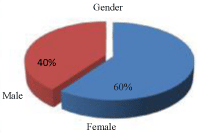
Figure 1: Demographic data of the case group on admission (Gender).
As regards the gender, there was a non significant difference between the two outcome subgroups with P value 0.678 (Figure 2).

Figure 2: Gender difference between the two outcome subgroups.
Other demographic data of the case group are illustrated in Table 3 and Figure 3.

Figure 3: Other demographic data of the case group.
Number
Percent
DM
16
64%
HTN
16
64%
Smoking
5
20%
Dyslipidemia
8
32%
AF
3
12%
Liver dysfunction
2
8%
Renal impairment
7
28%
Drug induced coagulopathy
3
12%
Table 3: Other demographic data of the case group.
ICH volume and Scores: Table 4 shows the distribution of the two outcome subgroups as regards the ICH volume, GCS and mMRS. ICH volume and mMRS were significantly higher in bad outcome subgroup (94.00±28.48), (4.87±1.64) respectively than in good outcome subgroup (46.50±9.14), (0.70±0.48) respectively with P value 0.0001, whereas GCS was significantly lower in bad outcome subgroup (7.67±3.92) than in good outcome subgroup (13.900±0.74) with P value 0.0001 (Table 4 and Figure 4):
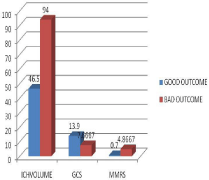
Figure 4: ICH volume and Scores in the two outcome subgroups.
Outcome
N
Mean
Std. Deviation
P value
ICH Volume
Good outcome
10
46.5000
9.14391
0.0001
Bad outcome
15
94.0000
28.48559
GCS
Good outcome
10
13.9000
0.73786
0.0001
Bad outcome
15
7.6667
3.92186
mMRS
Good outcome
10
0.7000
0.48305
0.0001
Bad outcome
15
4.8667
1.64172
Table 4: ICH volume and Scores in the two outcome subgroups.
ICAM levels the mean ICAM level of both groups (Case and Control) is illustrated in Table 5 and Figure 5: ICAM level on admission was significantly higher in the case group in comparison to the control group with P value 0.001.

Figure 5: The mean ICAM level of both groups.
Group
N
Mean
Std. Deviation
P value
ICAM0
Case
5
22.4000
699.90642
0.001
Control
5
1.3200
56.62208
Table 5: The mean ICAM level of both groups.
The mean ICAM levels of the two outcome subgroups (good and bad outcome): The ICAM 0, 1and 2 were significantly higher in bad outcome subgroup and continued in rising for serum level as compared to good outcome subgroup which declined by the third reading, as shown in Figure 6.
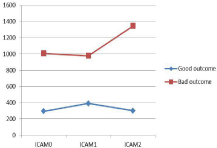
Figure 6: The mean ICAM levels of the two outcome subgroups.
ICAM and seizure
ICAM0 and seizure: The predictivity of ICAM0 for seizure was assessed to have sensitivity 100% and specificity 81% at the level of 680 ng/ml with AUC 0.911 and P value 0.011 (Table 6 and Figure 7).

Figure 7: ROC analysis for prediction of seizure with ICAM0 in group 1.
AUC
Cutoff value
P value
Sensitivity
ICAM0 Specificity
0.911
680
0.011
100%
81%
0.911
680
0.011
100%
81%
Table 6: ROC analysis for prediction of seizure with ICAM0 in group 1.
ICAM1 and seizure: The predictivity of ICAM1 for seizure was assessed to have sensitivity 100% and specificity 67% at the level of 615 ng/ml with AUC 0.881 and P value 0.018 ( Table 7 and Figure 8).
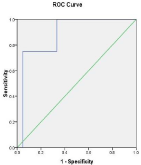
Figure 8: ROC analysis for prediction of seizure with ICAM1 in group 1.
AUC
Cutoff value
P value
Sensitivity
ICAM0 Specificity
0.881
615
0.018
100%
67%
Table 7: ROC analysis for prediction of seizure with ICAM1 in group 1.
ICAM2 and seizure: The predictivity of ICAM2 for seizure was assessed to have sensitivity 100% and specificity 81% at the level of 970 ng/ml with AUC 0.88 and P value 0.016 ( Table 8 and Figure 9).
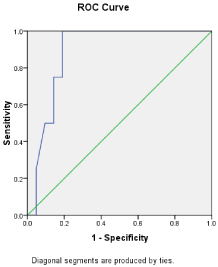
Figure 9: ROC analysis for prediction of seizure with ICAM2 in group 1.
7
Cutoff value
P value
Sensitivity
ICAM0 Specificity
0.88
970
0.016
100%
81%
Table 8: ROC analysis for prediction of seizure with ICAM2 in group 1.
ICAM and outcome: By analysis of ROC curve; ICAM level on admission at 455 ng/ml predicted a poor outcome with AUC 0.813, sensitivity 73% and specificity 80% with P value 0.009, for ICAM level on day 4 level of 460 ng/ml predicted a poor outcome with AUC 0.78, sensitivity 73% and specificity 90% with P value 0.018. Also, despite of lacking clinical value ICAM2 at day seven at 430 ng/ml predicted a poor outcome with AUC 0.957, sensitivity 90% and specificity 70% with P value 0.0001 as shown in Figures 10-12.

Figure 10: ROC analysis for prediction of outcome with ICAM0 in group 1.

Figure 11: ROC analysis for prediction of outcome with ICAM1 in group 1.
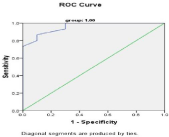
Figure 12: ROC analysis for prediction of outcome with ICAM2 in group 1.
Discussion
By taking ICAM as a chemical biomarker for early inflammatory process that correlates to ICH, we compared the two studied groups (case and control groups) and we found that ICAM levels on admission were significantly higher in case group with P value 0.001 and the ICAM levels showed progressive increase at day four and day seven in the case group.
In other studies that compared cases of ICH with volunteers, plasma sICAM-1 and sVCAM-1 levels were elevated significantly after the onset of ICH and peaked on days 10 (sICAM-1) and 4 (sVCAM-1) and then slightly decreased thereafter [9].
Same data were obtained in different types of intracranial hemorrhage, Kaynar et al. [10] studied ICAM and VCAM levels in CSF and sera of patients with acute subarachnoid hemorrhage and found that their levels were elevated in case group compared to those of healthy controls.
Regarding ICH volume, there was a significant relation that larger hematoma volume than 57.5 CM3 predicted bad outcome with a sensitivity of 86.7% and specificity 90% and this was in concordance with Pipat et al who conducted a study by the year 2009 over 131 non traumatic intra cranial hemorrhage, (81 of them ICH), and they concluded that the two variables on CT imaging, identified as significant as early mortality predictors, were hematoma volume more than 60 CM3, and presence of intraventricular hemorrhage extension [11].
In our study, the incidence of IVH was significantly higher in the bad outcome subgroup with P value 0.051, that is consistent with the results of the study by Pipat et al in 2009 in which survived patients associated with absent intraventricular hemorrhage extension and death associated with presence of intraventricular hemorrhage (P value 0.003), also this result agrees with that reported by Hung- Chen Wang et al in 2011 in which patients with bad outcome had a significant incidence of intraventricular hemorrhage extension with P value 0.006.
In our study, the incidence of clinical seizures comprised 4/25 (16%) that was in acceptable frequency as reported by different studies within the first 2 weeks in ICH that ranged from 2.7% to 17%, with the majority occurring at or near onset [12,13].
In a large, single-center study, prophylactic antiepileptic drugs did significantly reduce the number of clinical seizures after lobar ICH [10]. However, in prospective and population-based studies, clinical seizures have not been associated with worsened neurological outcome or mortality [12,14].
The clinical impact of subclinical seizures detected on EEG is also not clear. A recent analysis from the placebo arm of an ICH neuroprotectant study found that patients who received antiepileptic drugs (primarily phenytoin) without a documented seizure were significantly more likely to be dead or disabled at 90 days, after adjusting for other established predictors of ICH outcome [13]. Another recent single-center observational study had similar findings, specifically for phenytoin [15]. Thus only clinical seizures or electrographic seizures in patients with a change in mental status should be treated with antiepileptic drugs. Continuous EEG monitoring should be considered in ICH patients with depressed mental status out of proportion to the degree of brain injury. The utility of prophylactic anticonvulsant medication remains uncertain [16].

Graph 1:
In our study clinical seizures were accompanied with poor outcome and a higher ICAM level throughout the hospital course till day 7. By analysis of ROC curve; ICAM level at 680 ng/ml predicted clinical seizures at sensitivity 100% and specificity 81% that could be used in the future with concurrent EEG or alone to recommend prescription of prophylactic anticonvulsants in case of ICH.
The ROC curves analysis in the study by Hung-Cheng Wang et al revealed that the cutoff point of sICAM-1 on admission was 194.61 ng/mL could predict poor outcome with (sensitivity of 68.8%, specificity of 71.4%, AUC of 0.717) and there were no mortalities [4].
In our study by analysis of ROC curve different cutoff points for egyptian population for ICAM0 at 455 predicted poor outcome with AUC 0.81, sensitivity 73% and specificity 80%, ICAMI at 460 predicted poor outcome with AUC 0.78, sensitivity 73% and specificity 90% and ICAM2 at 460 predicted poor outcome with AUC 0.95, sensitivity 90% and specificity 70%. As regards the mortality, by analysis of ROC curve different cutoff points for Egyptian population for ICAM0 at 505 predicted non survivors with AUC 0.878, sensitivity 89% and specificity 88%, ICAMI at 460 predicted non survivors with AUC 0.938, sensitivity 100% and specificity 82% and ICAM2 at 475 predicted non survivors with AUC 0.924, sensitivity 100% and specificity 75%.
In the near future, additional strategies that target inflammation in the very early phase of hemostasis [17] could offer exciting new promise in the therapeutic approach to ICH.
Conclusion
1. An increase in sICAM level implies a danger of poor therapeutic outcome for the treatment of spontaneous ICH during hospitalization.
2. Further large-scale studies are needed to elucidate the relevance of serum concentrations of adhesion molecules and secondary brain injury after spontaneous ICH.
References
- Bonita R, Beaglehole R. Modification of Rankin Scale: Recovery of motor function after stroke. Stroke. 1988; 19: 1497-1500.
- Van Swieten JC, Koudstaal PJ, Visser MC, Schouten HJ, van Gijn J. Interobserver agreement for the assessment of handicap in stroke patients. Stroke. 1988; 19: 604-607.
- Wang J, Dore S. Inflammation after intracerebral hemorrhage. Journal of Cerebral Blood Flow & Metabolism. 2007; 27: 894-908.
- Wang HC, Lin WC, Lin YJ, Rau CS, Lee TH, Chang WN, et al. The association between serum adhesion molecules and outcome in acute spontaneous intracerebral. Critical Care. 2011; 15: R284.
- Rankin J. Cerebral vascular accidents in patients over the age of 60. Scott Med J. 1957; 2: 200-215.
- Jim Haggis. Radical statistician. 2005.
- Pepe MS, Janes H, Longton G, Leisenring W, Newcomb P. Limitations of the odds ratio in gauging the performance of a diagnostic, prognostic, or screening marker. American Journal of Epidemiology. 2004; 159: 882-890.
- Xiao-Hua Zhou, Nancy A. Obuchowski, Donna K. McClish. Statistical methods in diagnostic medicine. Wiley & Sons. 2002.
- Yang TM, Lin WC, Chang WN, Ho JT, Wang HC, Tsai NW, et al. Predictors and outcome of seizures after spontaneous intracerebral hemorrhage. Clinical article. J Neurosurg. 2009; 111: 87-93.
- Passero S, Rocchi R, Rossi S, Ulivelli M, Vatti G. Seizures after spontaneous supratentorial intracerebral hemorrhage. Epilepsia. 2002; 43: 1175-1180.
- Chiewvit P, Danchaivijitr N, Nilanont Y, Poungvarin N. Computed Tomographic Findings in Non-traumatic Hemorrhagic Stroke. J Med Assoc Thai. 2009; 92: 73-86.
- Szaflarski JP, Rackley AY, Kleindorfer DO, Khoury J, Woo D, Miller R, et al. Incidence of seizures in the acute phase of stroke: a population-based study. Epilepsia. 2008; 49: 974-981.
- Messé SR, Sansing LH, Cucchiara BL, Herman ST, Lyden PD, Kasner SE, et al. Prophylactic antiepileptic drug use is associated with poor outcome following ICH. Neurocrit Care. 2009; 11: 38-44.
- Bladin CF, Alexandrov AV, Bellavance A, Bornstein N, Chambers B, Coté R, et al. Seizures after stroke: a prospective multicenter study. Arch Neurol. 2000; 57: 1617-1622.
- Naidech AM, Garg RK, Liebling S, Levasseur K, Macken MP, Schuele SU, et al. Anticonvulsant use and outcomes after intracerebral hemorrhage. Stroke. 2009; 40: 3810 -3815.
- Lewis B Morgenstern, Hemphill JC, Anderson C, Kyra Becker, Joseph P. Broderick, E. Sander Connolly, et al. Guidelines for the Management of Spontaneous Intracerebral Hemorrhage: A Guideline for Healthcare Professionals from the American Heart Association/American Stroke Association. Stroke. 2010; 41: 2108-2129.
- Mayer SA, Rincon F. Treatment of intracerebral hemorrhage. Lancet Neurol. 2005; 4: 662-672.